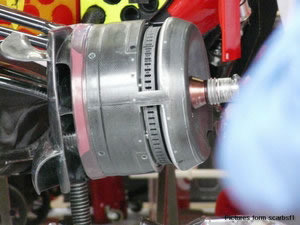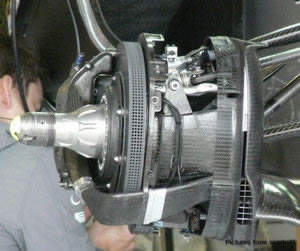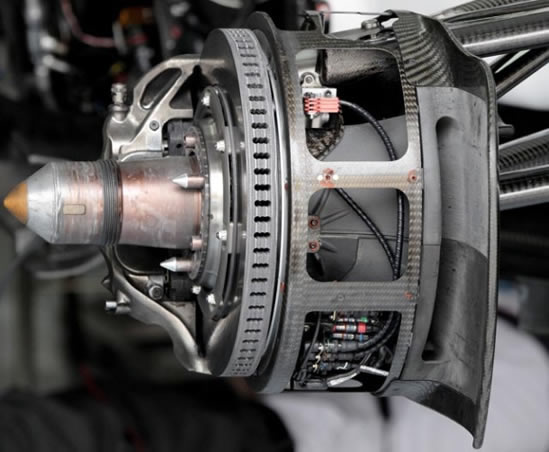Brake by Wire or BBW
After FIA introduced brake by wire system in new 2014 rules, I find a lot of speculations about it's work, what does this mean and what it bring to Formula 1. Especially is a fun to follow some forums and explanations that some people offer without reading rules. A lot of fans are in dilemma that this news can open a gate for cheating with some ABS's, traction controls or some other kind of forbidden system hidden in the depths of software. While Formula 1 people make everything sound overly technical, effectively Formula 1 cars are adapting the 'brake pedal feel simulator' that most road car hybrid drivers, especially Chevy Volt and Prius owners, will be very familiar with, and from all reports it's taking the drivers some time to get used to it.
Without doubt a few would have been thinking how to gain extra benefits out of the system. Time will tell however we will be seeing some very clever use of the new ERS system over the course of the year and years to come.
Brake-by-wire (partialy reproduced)
From Wikipedia, the free encyclopedia
Brake-by-wire technology in automotive industry is the ability to control brakes through electrical means. It can be designed to supplement ordinary service brakes or it can be a standalone brake system.
Brake-by-wire technology in automotive industry represents the replacement of traditional components such as the pumps, hoses, fluids, belts and vacuum servos and master cylinders with electronic sensors and actuators. Drive-by-wire technology in automotive industry replaces the traditional mechanical and hydraulic control systems with electronic control systems using electromechanical actuators and human-machine interfaces such as pedal and steering feel emulators.
Some x-by-wire technologies have been already installed on commercial vehicles such as steer-by-wire, and throttle-by-wire. Brake-by-wire technology is still under development by some automobile and automotive parts manufacturers industry worldwide and has not been widely commercialized yet. This is mainly due to the safety-critical nature of brake products. So far, Mercedes-Benz (Sensotronic) and Toyota (Electronically Controlled Brake) already use almost fully brake-by-wire systems, on the Mercedes-Benz E-class and SL models and on Toyota's Estima.
Basically it's only partially brake-by-wire system. "By-wire" means that the control input is physically disconnected from the mechanical end device we want to control. There is no physical linkage between the control input and the mechanical device on the car except electical wire. In planes (fly-by-wire) the pedals and stick are attached by wire (electrical wire) to a computer that measures the input and then translates that to the control surfaces. So, translate this to cars (both road and racing) and you get things like "throttle-by-wire" which has been in Formula 1 for quite some time. Instead of the throttle being connected directly to the engine, it's connected to a computer. It measures input, takes other things into account and applies that to the engine throttle. When you hear things like "throttle mapping" this is what is being referred to. For instance when the car is in rain mode, the throttle response is slower to prevent wheel spin due to lower grip. In dry running, the throttle response is much faster.
 In 2009, the first year of using an energy recovery system, there were several drivers who had issues in managing the braking distance which varied significantly when KERS was charging or not. Over time, the adoption of appropriate electronic strategies allowed teams to eliminate the problems and allowed exploitation of an even more exasperated braking phase. As we've seen, KERS recovery does weird things to the behavior of the car under braking because it affects the brake balance, brake bias and the balance of the rear axle. However, KERS was very much bolted on to pre 2014 cars, where as in 2014 it is completely integrated in the power unit. ERS is so much more powerful on these new cars compared to the KERS on the 2013 cars with harvested energy when the car is braking – 161bhp of energy compared to 80bhp with the old KERS. This requires much greater variations in rear wheel braking torque than previously. Problem occurs with the addition of a few variables: braking itself, engine braking and ERS-K harvesting which is not always the same. The action of what we commonly call "engine braking" will be much more effective than before, and ad to that uneven energy harvesting. And then it will be interesting to see how it will be possible to modulate and braking at the same point of the track at every lap depending on how much recovery systems will be able to help the braking. Because of this, we don't know how they'll affect the cars under braking.
In 2009, the first year of using an energy recovery system, there were several drivers who had issues in managing the braking distance which varied significantly when KERS was charging or not. Over time, the adoption of appropriate electronic strategies allowed teams to eliminate the problems and allowed exploitation of an even more exasperated braking phase. As we've seen, KERS recovery does weird things to the behavior of the car under braking because it affects the brake balance, brake bias and the balance of the rear axle. However, KERS was very much bolted on to pre 2014 cars, where as in 2014 it is completely integrated in the power unit. ERS is so much more powerful on these new cars compared to the KERS on the 2013 cars with harvested energy when the car is braking – 161bhp of energy compared to 80bhp with the old KERS. This requires much greater variations in rear wheel braking torque than previously. Problem occurs with the addition of a few variables: braking itself, engine braking and ERS-K harvesting which is not always the same. The action of what we commonly call "engine braking" will be much more effective than before, and ad to that uneven energy harvesting. And then it will be interesting to see how it will be possible to modulate and braking at the same point of the track at every lap depending on how much recovery systems will be able to help the braking. Because of this, we don't know how they'll affect the cars under braking.
That's why FIA was forced to allow the adoption of an electronically controlled brake balance. 2014 tech regulations introduce new rule which allow teams to use electronic brake assistance on rear wheels, so called brake-by-wire system or BBW, which electronically applies (actually just regulate applied force) force to the rear brakes so that they work in harmony with the energy recovery system under deceleration and during the harvesting to compensate for the powerful effect that ERS-K has on brake balance and braking stability. This makes it acceptable for the driver and doesn’t destabilize the car with a sudden balance shift.
An F1 car has two brake systems for safety – front and rear – so that if one fails the other will stop the car. The front and rear brakes are still physically connected to the brake pedal through the hydraulic lines. Only difference is that rear wheels braking system (hydraulic lines supplying rear brake calipers with hydraulic fluid) must have build in a bleeding valve. This valve will, at command form ECU, release (relive) excess pressure of the fluid if ECU feel that pressure applied by driver is too high. FIA call this valve "ERS brake pressure reducing valve". That's why I sad it's partially brake-by-wire system.
Here is the exact wording of the new technical regulation on brake-by-wire:
11.7 ERS brake valve:
The pressure generated by the driver in the rear brake circuit may be reduced by the use of an ERS brake pressure reducing valve. The valve must be manufactured by an FIA designated supplier and installed in accordance with the fitting instructions which may be found in the Appendix to the Technical Regulations.
Any such valve may only be controlled by the control electronics described in Article 8.2.
Brake bias is still driver selectable from steering wheel or separate mechanical lever in the cockpit.
Thanks to special electronic mapping, BBW can modulate the force to give to the rear brakes, according to the driver pressure on the brake pedal, while at the same time take into account the energy taken from the brake discs by the MGU-K. This electronic system will try to keep the rear braking force the same no matter how much ERS harvesting is going on. Brake pedal position will call for a certain negative torque and the computer will figure out how it wants to achieve that between the ERS and hydraulic actuators. If pressure applied by driver is to high, ERS brake pressure reducing valve will bleed excess hydraulic fluid back to fluid tank. This has become necessary due to the significantly increased harvesting performance of the ERS, which requires much greater variations in rear wheel braking torque than previously.
It doesn't matter if you use friction brakes, engine braking or a generator, anything that retards the rotation of the rear wheels can cause a lock-up. And uneven harvesting of energy can cause exactly that. Engineers recognized that the braking capacity provided by MGU-K will be such that it will make braking problematic for the drivers. With brake-by-wire, an electronic system measures how hard the driver presses the brake pedal and then – using the additional information from ERS-K assess in a split-second how much brake pressure driver actually need when he presses the pedal and an electronic system modulates the power to the rear brakes calipers by bleeding excess pressure, allowing for additional ERS braking effect, that is taking energy to charge up the MGU-K unit. Level of these modulations can be changed in split second. It smoothes out the process of braking, slowing the car in a consistent way at the same time as ensuring the maximum energy harvest for the ERS without any problem for driver feeling.
 This makes it acceptable for the driver and doesn’t destabilize the car with a sudden balance or braking force shift. A lot of the lap time in modern Formula 1 comes from stable braking and that's why is easy to understand how important it is to have a good Brake-By-Wire system. What the system certainly would do is making the brake balance and the KERS harvesting easier for the drivers to control.
This makes it acceptable for the driver and doesn’t destabilize the car with a sudden balance or braking force shift. A lot of the lap time in modern Formula 1 comes from stable braking and that's why is easy to understand how important it is to have a good Brake-By-Wire system. What the system certainly would do is making the brake balance and the KERS harvesting easier for the drivers to control.
Ideally, the driver would feel nothing unusual with this system, in that it should provide consistent and stable braking. The job of the new rear brakes system is to ensure consistency. But that has proved to be quite challenging for a number of teams and drivers to adjust to during preseason testing. To understand how complicated this kind of system is for engineers – after the first winter testing session in Jerez, the Sauber F1 Team rebuilt the whole system because it was miscalibrated and caused their drivers to lose control and spin the car several times.
As a backup, driver pedal is still hydraulically connected to rear calipers, and braking must be possible even if electronic brake-by-wire system fail.
Here is what Brembo have to say about BBW system:
Back to the top of the page








